Analysis of Sustainable Supply Chain Performance Framework for FI(s)
VerifiedAdded on 2021/02/18
|39
|12184
|23
Report
AI Summary
This report examines a sustainable supply chain performance framework specifically tailored for financial institutions (FI(s)). The research begins with an overview of sustainable development and supply chain management, highlighting the challenges faced by financial organizations, particularly after global crises. The study explores key concepts like supply chain financing and sustainable supply chains, emphasizing the role of FI(s) in managing financial resources and promoting sustainable business practices among suppliers. The methodology includes a descriptive research design, interpretive philosophy, and qualitative data analysis, with data collected from both primary and secondary sources. The report outlines the research aim, objectives, and questions, focusing on the framework's ability to achieve social, economic, and governance goals, improve stakeholder value, and address financial challenges. The framework itself incorporates elements such as research design, philosophy, type, approach, and data analysis methods. The structure of the report is organized into chapters covering introduction, literature review, research methodology, data analysis, and recommendations and conclusions, providing a comprehensive analysis of sustainable supply chain management in the financial sector. The report emphasizes the importance of teamwork, transparency, and traceability in achieving effective sustainable supply chain management within the financial industry, suggesting that organizations can gain competitive advantages through this approach.
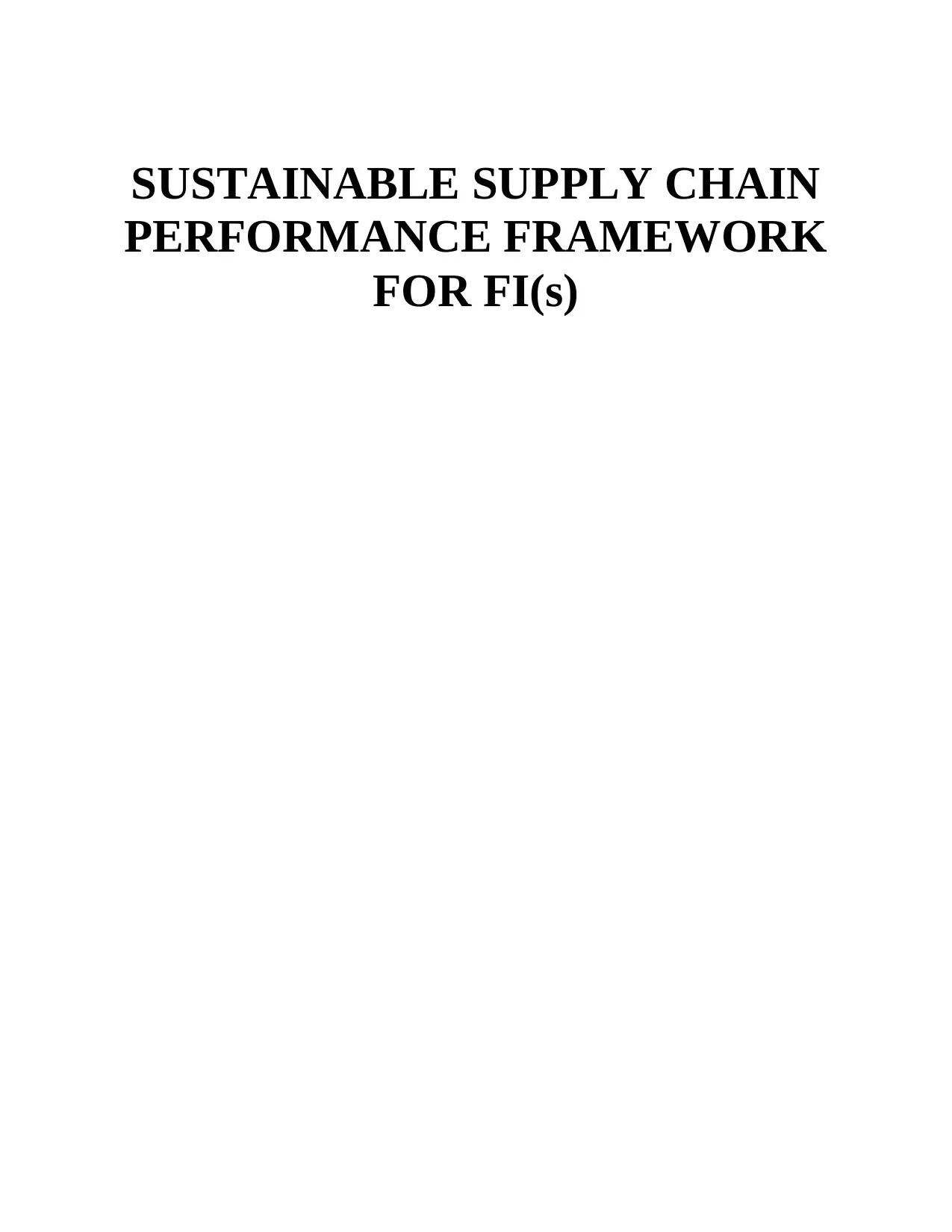
SUSTAINABLE SUPPLY CHAIN
PERFORMANCE FRAMEWORK
FOR FI(s)
PERFORMANCE FRAMEWORK
FOR FI(s)
Paraphrase This Document
Need a fresh take? Get an instant paraphrase of this document with our AI Paraphraser
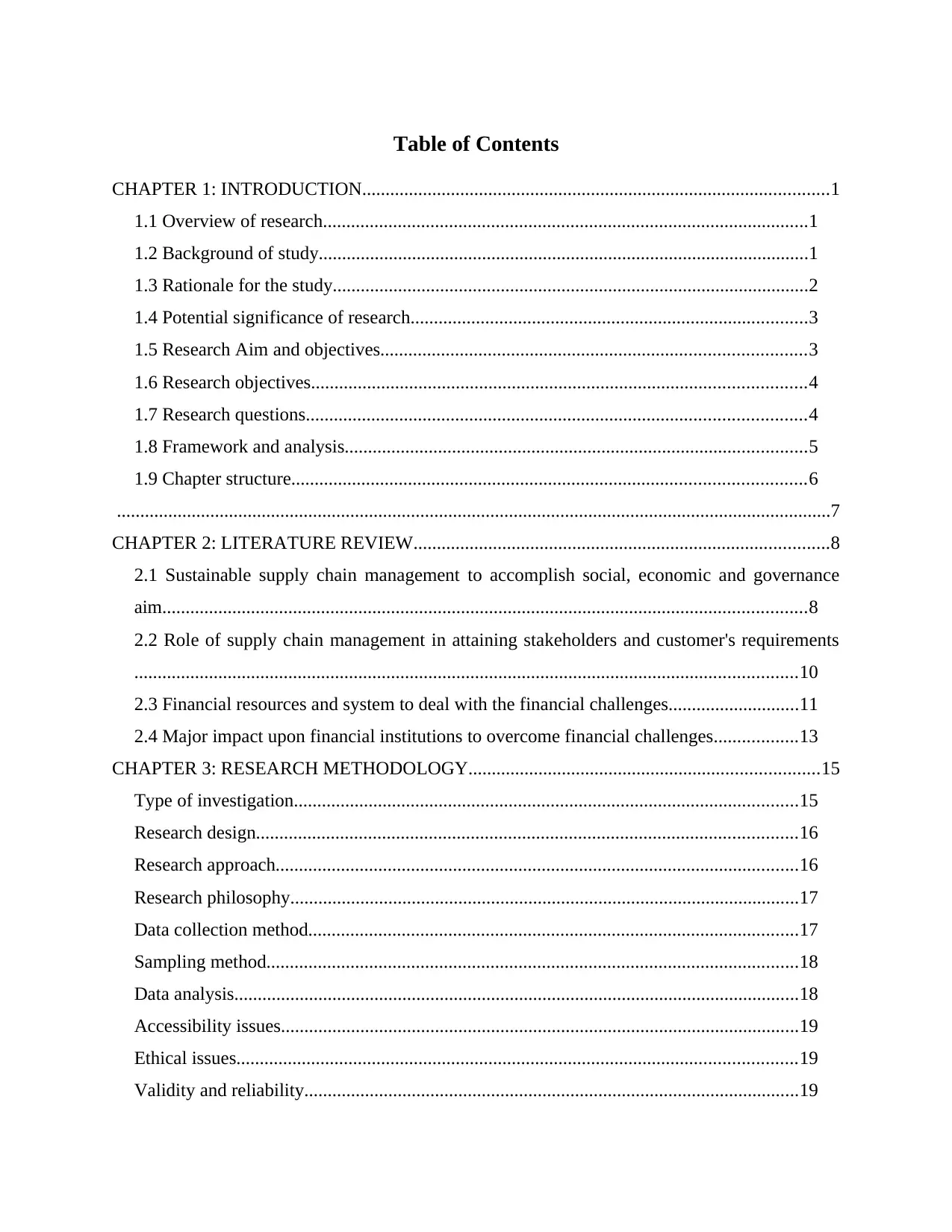
Table of Contents
CHAPTER 1: INTRODUCTION....................................................................................................1
1.1 Overview of research........................................................................................................1
1.2 Background of study.........................................................................................................1
1.3 Rationale for the study......................................................................................................2
1.4 Potential significance of research.....................................................................................3
1.5 Research Aim and objectives...........................................................................................3
1.6 Research objectives..........................................................................................................4
1.7 Research questions...........................................................................................................4
1.8 Framework and analysis...................................................................................................5
1.9 Chapter structure..............................................................................................................6
.........................................................................................................................................................7
CHAPTER 2: LITERATURE REVIEW.........................................................................................8
2.1 Sustainable supply chain management to accomplish social, economic and governance
aim..........................................................................................................................................8
2.2 Role of supply chain management in attaining stakeholders and customer's requirements
..............................................................................................................................................10
2.3 Financial resources and system to deal with the financial challenges............................11
2.4 Major impact upon financial institutions to overcome financial challenges..................13
CHAPTER 3: RESEARCH METHODOLOGY...........................................................................15
Type of investigation............................................................................................................15
Research design....................................................................................................................16
Research approach................................................................................................................16
Research philosophy.............................................................................................................17
Data collection method.........................................................................................................17
Sampling method..................................................................................................................18
Data analysis.........................................................................................................................18
Accessibility issues...............................................................................................................19
Ethical issues........................................................................................................................19
Validity and reliability..........................................................................................................19
CHAPTER 1: INTRODUCTION....................................................................................................1
1.1 Overview of research........................................................................................................1
1.2 Background of study.........................................................................................................1
1.3 Rationale for the study......................................................................................................2
1.4 Potential significance of research.....................................................................................3
1.5 Research Aim and objectives...........................................................................................3
1.6 Research objectives..........................................................................................................4
1.7 Research questions...........................................................................................................4
1.8 Framework and analysis...................................................................................................5
1.9 Chapter structure..............................................................................................................6
.........................................................................................................................................................7
CHAPTER 2: LITERATURE REVIEW.........................................................................................8
2.1 Sustainable supply chain management to accomplish social, economic and governance
aim..........................................................................................................................................8
2.2 Role of supply chain management in attaining stakeholders and customer's requirements
..............................................................................................................................................10
2.3 Financial resources and system to deal with the financial challenges............................11
2.4 Major impact upon financial institutions to overcome financial challenges..................13
CHAPTER 3: RESEARCH METHODOLOGY...........................................................................15
Type of investigation............................................................................................................15
Research design....................................................................................................................16
Research approach................................................................................................................16
Research philosophy.............................................................................................................17
Data collection method.........................................................................................................17
Sampling method..................................................................................................................18
Data analysis.........................................................................................................................18
Accessibility issues...............................................................................................................19
Ethical issues........................................................................................................................19
Validity and reliability..........................................................................................................19
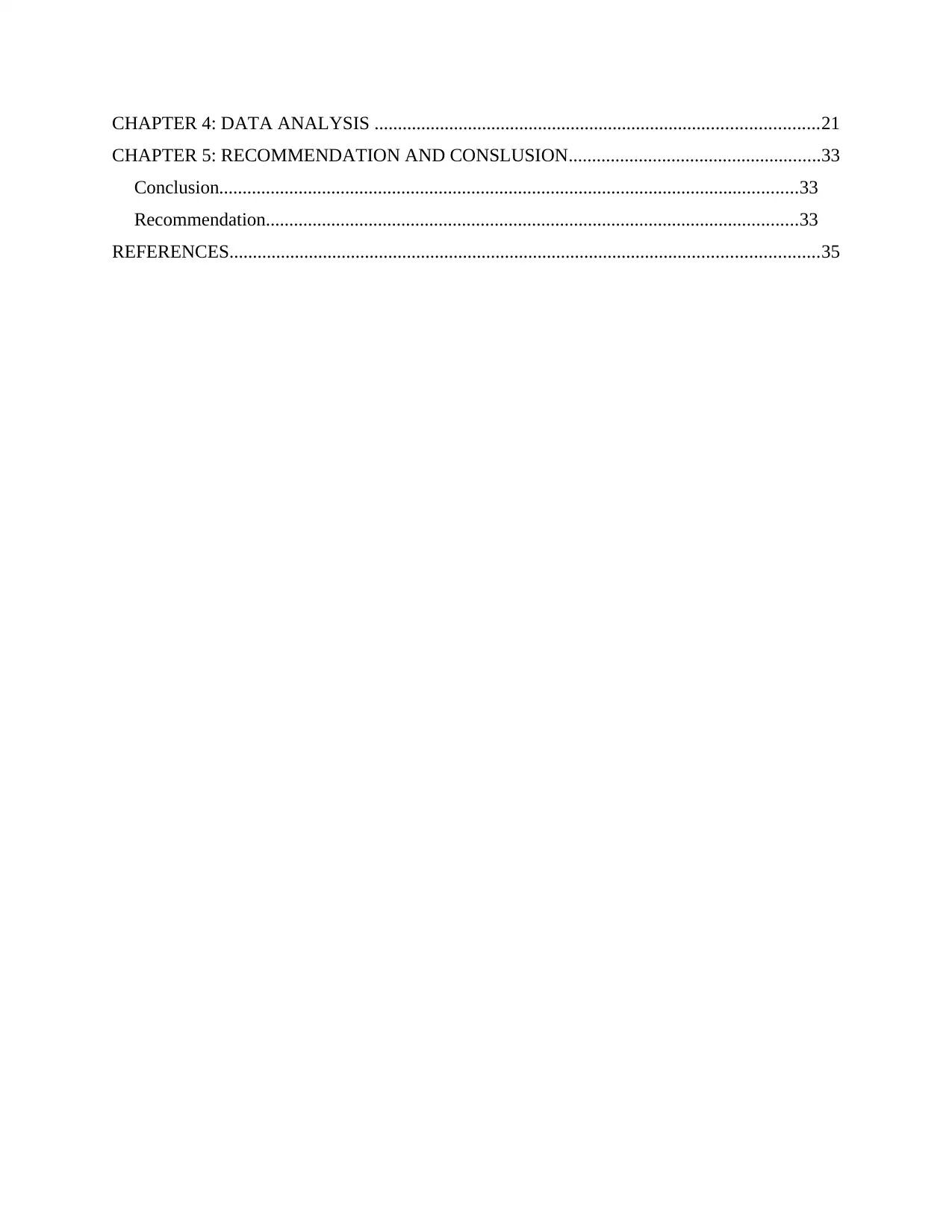
CHAPTER 4: DATA ANALYSIS ...............................................................................................21
CHAPTER 5: RECOMMENDATION AND CONSLUSION......................................................33
Conclusion............................................................................................................................33
Recommendation..................................................................................................................33
REFERENCES..............................................................................................................................35
CHAPTER 5: RECOMMENDATION AND CONSLUSION......................................................33
Conclusion............................................................................................................................33
Recommendation..................................................................................................................33
REFERENCES..............................................................................................................................35
⊘ This is a preview!⊘
Do you want full access?
Subscribe today to unlock all pages.

Trusted by 1+ million students worldwide
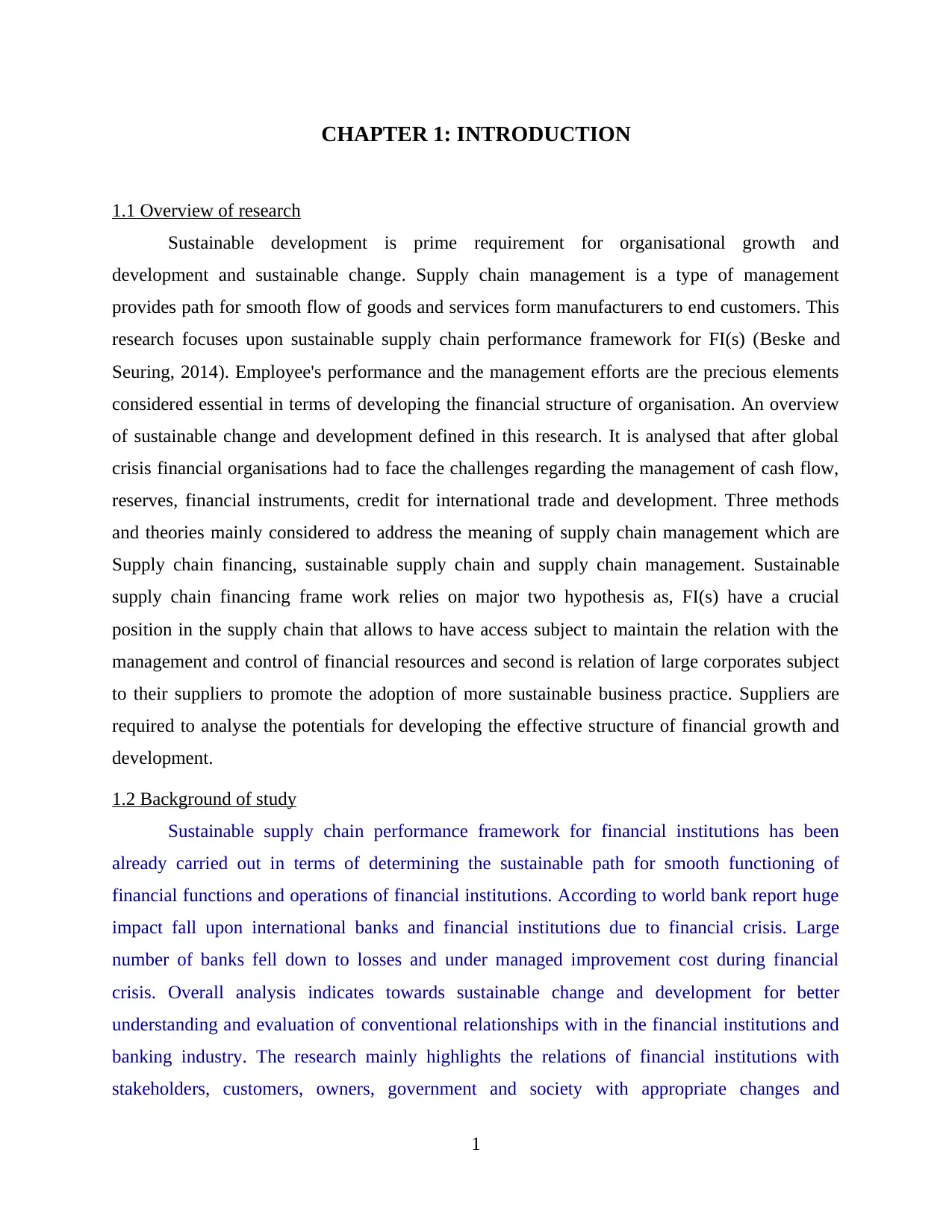
CHAPTER 1: INTRODUCTION
1.1 Overview of research
Sustainable development is prime requirement for organisational growth and
development and sustainable change. Supply chain management is a type of management
provides path for smooth flow of goods and services form manufacturers to end customers. This
research focuses upon sustainable supply chain performance framework for FI(s) (Beske and
Seuring, 2014). Employee's performance and the management efforts are the precious elements
considered essential in terms of developing the financial structure of organisation. An overview
of sustainable change and development defined in this research. It is analysed that after global
crisis financial organisations had to face the challenges regarding the management of cash flow,
reserves, financial instruments, credit for international trade and development. Three methods
and theories mainly considered to address the meaning of supply chain management which are
Supply chain financing, sustainable supply chain and supply chain management. Sustainable
supply chain financing frame work relies on major two hypothesis as, FI(s) have a crucial
position in the supply chain that allows to have access subject to maintain the relation with the
management and control of financial resources and second is relation of large corporates subject
to their suppliers to promote the adoption of more sustainable business practice. Suppliers are
required to analyse the potentials for developing the effective structure of financial growth and
development.
1.2 Background of study
Sustainable supply chain performance framework for financial institutions has been
already carried out in terms of determining the sustainable path for smooth functioning of
financial functions and operations of financial institutions. According to world bank report huge
impact fall upon international banks and financial institutions due to financial crisis. Large
number of banks fell down to losses and under managed improvement cost during financial
crisis. Overall analysis indicates towards sustainable change and development for better
understanding and evaluation of conventional relationships with in the financial institutions and
banking industry. The research mainly highlights the relations of financial institutions with
stakeholders, customers, owners, government and society with appropriate changes and
1
1.1 Overview of research
Sustainable development is prime requirement for organisational growth and
development and sustainable change. Supply chain management is a type of management
provides path for smooth flow of goods and services form manufacturers to end customers. This
research focuses upon sustainable supply chain performance framework for FI(s) (Beske and
Seuring, 2014). Employee's performance and the management efforts are the precious elements
considered essential in terms of developing the financial structure of organisation. An overview
of sustainable change and development defined in this research. It is analysed that after global
crisis financial organisations had to face the challenges regarding the management of cash flow,
reserves, financial instruments, credit for international trade and development. Three methods
and theories mainly considered to address the meaning of supply chain management which are
Supply chain financing, sustainable supply chain and supply chain management. Sustainable
supply chain financing frame work relies on major two hypothesis as, FI(s) have a crucial
position in the supply chain that allows to have access subject to maintain the relation with the
management and control of financial resources and second is relation of large corporates subject
to their suppliers to promote the adoption of more sustainable business practice. Suppliers are
required to analyse the potentials for developing the effective structure of financial growth and
development.
1.2 Background of study
Sustainable supply chain performance framework for financial institutions has been
already carried out in terms of determining the sustainable path for smooth functioning of
financial functions and operations of financial institutions. According to world bank report huge
impact fall upon international banks and financial institutions due to financial crisis. Large
number of banks fell down to losses and under managed improvement cost during financial
crisis. Overall analysis indicates towards sustainable change and development for better
understanding and evaluation of conventional relationships with in the financial institutions and
banking industry. The research mainly highlights the relations of financial institutions with
stakeholders, customers, owners, government and society with appropriate changes and
1
Paraphrase This Document
Need a fresh take? Get an instant paraphrase of this document with our AI Paraphraser
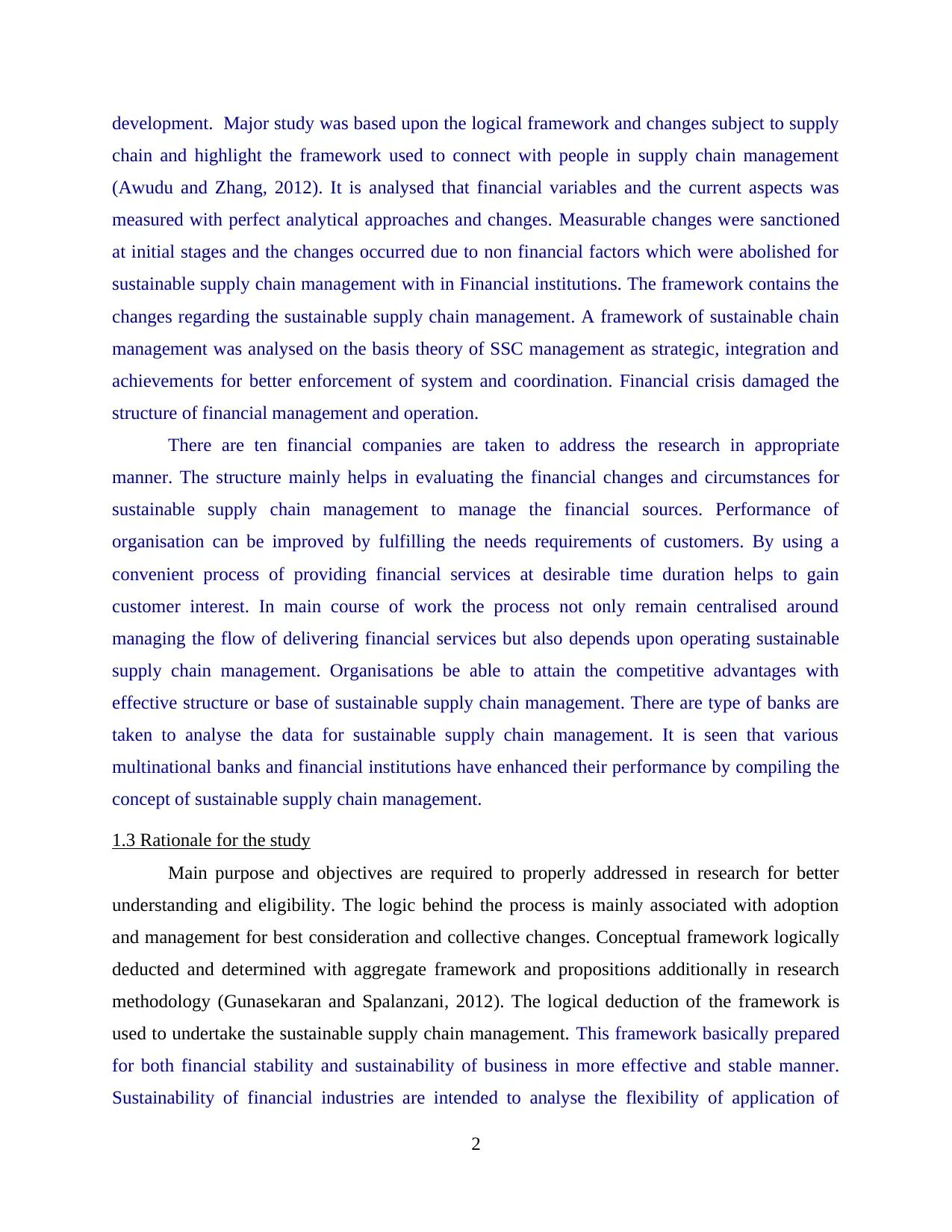
development. Major study was based upon the logical framework and changes subject to supply
chain and highlight the framework used to connect with people in supply chain management
(Awudu and Zhang, 2012). It is analysed that financial variables and the current aspects was
measured with perfect analytical approaches and changes. Measurable changes were sanctioned
at initial stages and the changes occurred due to non financial factors which were abolished for
sustainable supply chain management with in Financial institutions. The framework contains the
changes regarding the sustainable supply chain management. A framework of sustainable chain
management was analysed on the basis theory of SSC management as strategic, integration and
achievements for better enforcement of system and coordination. Financial crisis damaged the
structure of financial management and operation.
There are ten financial companies are taken to address the research in appropriate
manner. The structure mainly helps in evaluating the financial changes and circumstances for
sustainable supply chain management to manage the financial sources. Performance of
organisation can be improved by fulfilling the needs requirements of customers. By using a
convenient process of providing financial services at desirable time duration helps to gain
customer interest. In main course of work the process not only remain centralised around
managing the flow of delivering financial services but also depends upon operating sustainable
supply chain management. Organisations be able to attain the competitive advantages with
effective structure or base of sustainable supply chain management. There are type of banks are
taken to analyse the data for sustainable supply chain management. It is seen that various
multinational banks and financial institutions have enhanced their performance by compiling the
concept of sustainable supply chain management.
1.3 Rationale for the study
Main purpose and objectives are required to properly addressed in research for better
understanding and eligibility. The logic behind the process is mainly associated with adoption
and management for best consideration and collective changes. Conceptual framework logically
deducted and determined with aggregate framework and propositions additionally in research
methodology (Gunasekaran and Spalanzani, 2012). The logical deduction of the framework is
used to undertake the sustainable supply chain management. This framework basically prepared
for both financial stability and sustainability of business in more effective and stable manner.
Sustainability of financial industries are intended to analyse the flexibility of application of
2
chain and highlight the framework used to connect with people in supply chain management
(Awudu and Zhang, 2012). It is analysed that financial variables and the current aspects was
measured with perfect analytical approaches and changes. Measurable changes were sanctioned
at initial stages and the changes occurred due to non financial factors which were abolished for
sustainable supply chain management with in Financial institutions. The framework contains the
changes regarding the sustainable supply chain management. A framework of sustainable chain
management was analysed on the basis theory of SSC management as strategic, integration and
achievements for better enforcement of system and coordination. Financial crisis damaged the
structure of financial management and operation.
There are ten financial companies are taken to address the research in appropriate
manner. The structure mainly helps in evaluating the financial changes and circumstances for
sustainable supply chain management to manage the financial sources. Performance of
organisation can be improved by fulfilling the needs requirements of customers. By using a
convenient process of providing financial services at desirable time duration helps to gain
customer interest. In main course of work the process not only remain centralised around
managing the flow of delivering financial services but also depends upon operating sustainable
supply chain management. Organisations be able to attain the competitive advantages with
effective structure or base of sustainable supply chain management. There are type of banks are
taken to analyse the data for sustainable supply chain management. It is seen that various
multinational banks and financial institutions have enhanced their performance by compiling the
concept of sustainable supply chain management.
1.3 Rationale for the study
Main purpose and objectives are required to properly addressed in research for better
understanding and eligibility. The logic behind the process is mainly associated with adoption
and management for best consideration and collective changes. Conceptual framework logically
deducted and determined with aggregate framework and propositions additionally in research
methodology (Gunasekaran and Spalanzani, 2012). The logical deduction of the framework is
used to undertake the sustainable supply chain management. This framework basically prepared
for both financial stability and sustainability of business in more effective and stable manner.
Sustainability of financial industries are intended to analyse the flexibility of application of
2
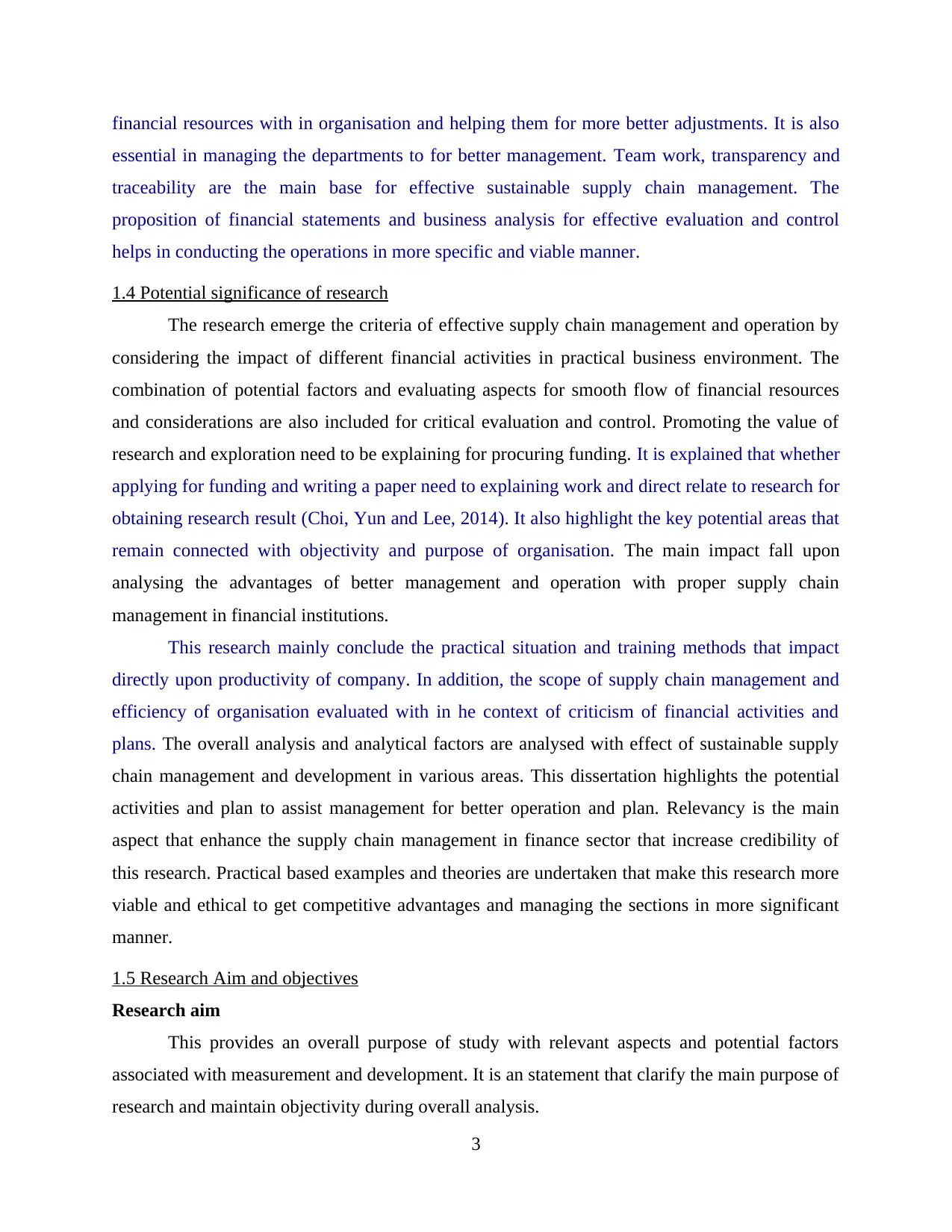
financial resources with in organisation and helping them for more better adjustments. It is also
essential in managing the departments to for better management. Team work, transparency and
traceability are the main base for effective sustainable supply chain management. The
proposition of financial statements and business analysis for effective evaluation and control
helps in conducting the operations in more specific and viable manner.
1.4 Potential significance of research
The research emerge the criteria of effective supply chain management and operation by
considering the impact of different financial activities in practical business environment. The
combination of potential factors and evaluating aspects for smooth flow of financial resources
and considerations are also included for critical evaluation and control. Promoting the value of
research and exploration need to be explaining for procuring funding. It is explained that whether
applying for funding and writing a paper need to explaining work and direct relate to research for
obtaining research result (Choi, Yun and Lee, 2014). It also highlight the key potential areas that
remain connected with objectivity and purpose of organisation. The main impact fall upon
analysing the advantages of better management and operation with proper supply chain
management in financial institutions.
This research mainly conclude the practical situation and training methods that impact
directly upon productivity of company. In addition, the scope of supply chain management and
efficiency of organisation evaluated with in he context of criticism of financial activities and
plans. The overall analysis and analytical factors are analysed with effect of sustainable supply
chain management and development in various areas. This dissertation highlights the potential
activities and plan to assist management for better operation and plan. Relevancy is the main
aspect that enhance the supply chain management in finance sector that increase credibility of
this research. Practical based examples and theories are undertaken that make this research more
viable and ethical to get competitive advantages and managing the sections in more significant
manner.
1.5 Research Aim and objectives
Research aim
This provides an overall purpose of study with relevant aspects and potential factors
associated with measurement and development. It is an statement that clarify the main purpose of
research and maintain objectivity during overall analysis.
3
essential in managing the departments to for better management. Team work, transparency and
traceability are the main base for effective sustainable supply chain management. The
proposition of financial statements and business analysis for effective evaluation and control
helps in conducting the operations in more specific and viable manner.
1.4 Potential significance of research
The research emerge the criteria of effective supply chain management and operation by
considering the impact of different financial activities in practical business environment. The
combination of potential factors and evaluating aspects for smooth flow of financial resources
and considerations are also included for critical evaluation and control. Promoting the value of
research and exploration need to be explaining for procuring funding. It is explained that whether
applying for funding and writing a paper need to explaining work and direct relate to research for
obtaining research result (Choi, Yun and Lee, 2014). It also highlight the key potential areas that
remain connected with objectivity and purpose of organisation. The main impact fall upon
analysing the advantages of better management and operation with proper supply chain
management in financial institutions.
This research mainly conclude the practical situation and training methods that impact
directly upon productivity of company. In addition, the scope of supply chain management and
efficiency of organisation evaluated with in he context of criticism of financial activities and
plans. The overall analysis and analytical factors are analysed with effect of sustainable supply
chain management and development in various areas. This dissertation highlights the potential
activities and plan to assist management for better operation and plan. Relevancy is the main
aspect that enhance the supply chain management in finance sector that increase credibility of
this research. Practical based examples and theories are undertaken that make this research more
viable and ethical to get competitive advantages and managing the sections in more significant
manner.
1.5 Research Aim and objectives
Research aim
This provides an overall purpose of study with relevant aspects and potential factors
associated with measurement and development. It is an statement that clarify the main purpose of
research and maintain objectivity during overall analysis.
3
⊘ This is a preview!⊘
Do you want full access?
Subscribe today to unlock all pages.

Trusted by 1+ million students worldwide
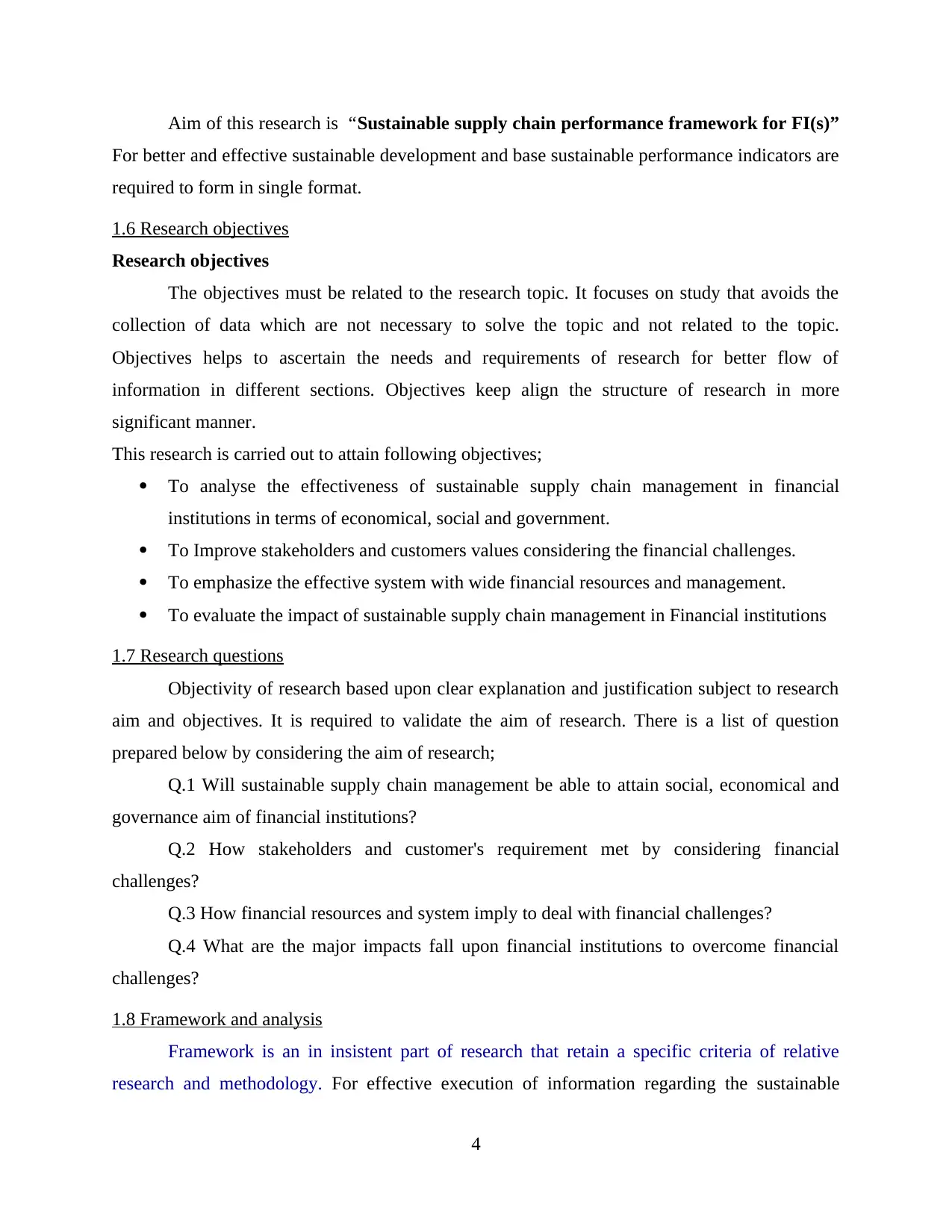
Aim of this research is “Sustainable supply chain performance framework for FI(s)”
For better and effective sustainable development and base sustainable performance indicators are
required to form in single format.
1.6 Research objectives
Research objectives
The objectives must be related to the research topic. It focuses on study that avoids the
collection of data which are not necessary to solve the topic and not related to the topic.
Objectives helps to ascertain the needs and requirements of research for better flow of
information in different sections. Objectives keep align the structure of research in more
significant manner.
This research is carried out to attain following objectives;
To analyse the effectiveness of sustainable supply chain management in financial
institutions in terms of economical, social and government.
To Improve stakeholders and customers values considering the financial challenges.
To emphasize the effective system with wide financial resources and management.
To evaluate the impact of sustainable supply chain management in Financial institutions
1.7 Research questions
Objectivity of research based upon clear explanation and justification subject to research
aim and objectives. It is required to validate the aim of research. There is a list of question
prepared below by considering the aim of research;
Q.1 Will sustainable supply chain management be able to attain social, economical and
governance aim of financial institutions?
Q.2 How stakeholders and customer's requirement met by considering financial
challenges?
Q.3 How financial resources and system imply to deal with financial challenges?
Q.4 What are the major impacts fall upon financial institutions to overcome financial
challenges?
1.8 Framework and analysis
Framework is an in insistent part of research that retain a specific criteria of relative
research and methodology. For effective execution of information regarding the sustainable
4
For better and effective sustainable development and base sustainable performance indicators are
required to form in single format.
1.6 Research objectives
Research objectives
The objectives must be related to the research topic. It focuses on study that avoids the
collection of data which are not necessary to solve the topic and not related to the topic.
Objectives helps to ascertain the needs and requirements of research for better flow of
information in different sections. Objectives keep align the structure of research in more
significant manner.
This research is carried out to attain following objectives;
To analyse the effectiveness of sustainable supply chain management in financial
institutions in terms of economical, social and government.
To Improve stakeholders and customers values considering the financial challenges.
To emphasize the effective system with wide financial resources and management.
To evaluate the impact of sustainable supply chain management in Financial institutions
1.7 Research questions
Objectivity of research based upon clear explanation and justification subject to research
aim and objectives. It is required to validate the aim of research. There is a list of question
prepared below by considering the aim of research;
Q.1 Will sustainable supply chain management be able to attain social, economical and
governance aim of financial institutions?
Q.2 How stakeholders and customer's requirement met by considering financial
challenges?
Q.3 How financial resources and system imply to deal with financial challenges?
Q.4 What are the major impacts fall upon financial institutions to overcome financial
challenges?
1.8 Framework and analysis
Framework is an in insistent part of research that retain a specific criteria of relative
research and methodology. For effective execution of information regarding the sustainable
4
Paraphrase This Document
Need a fresh take? Get an instant paraphrase of this document with our AI Paraphraser
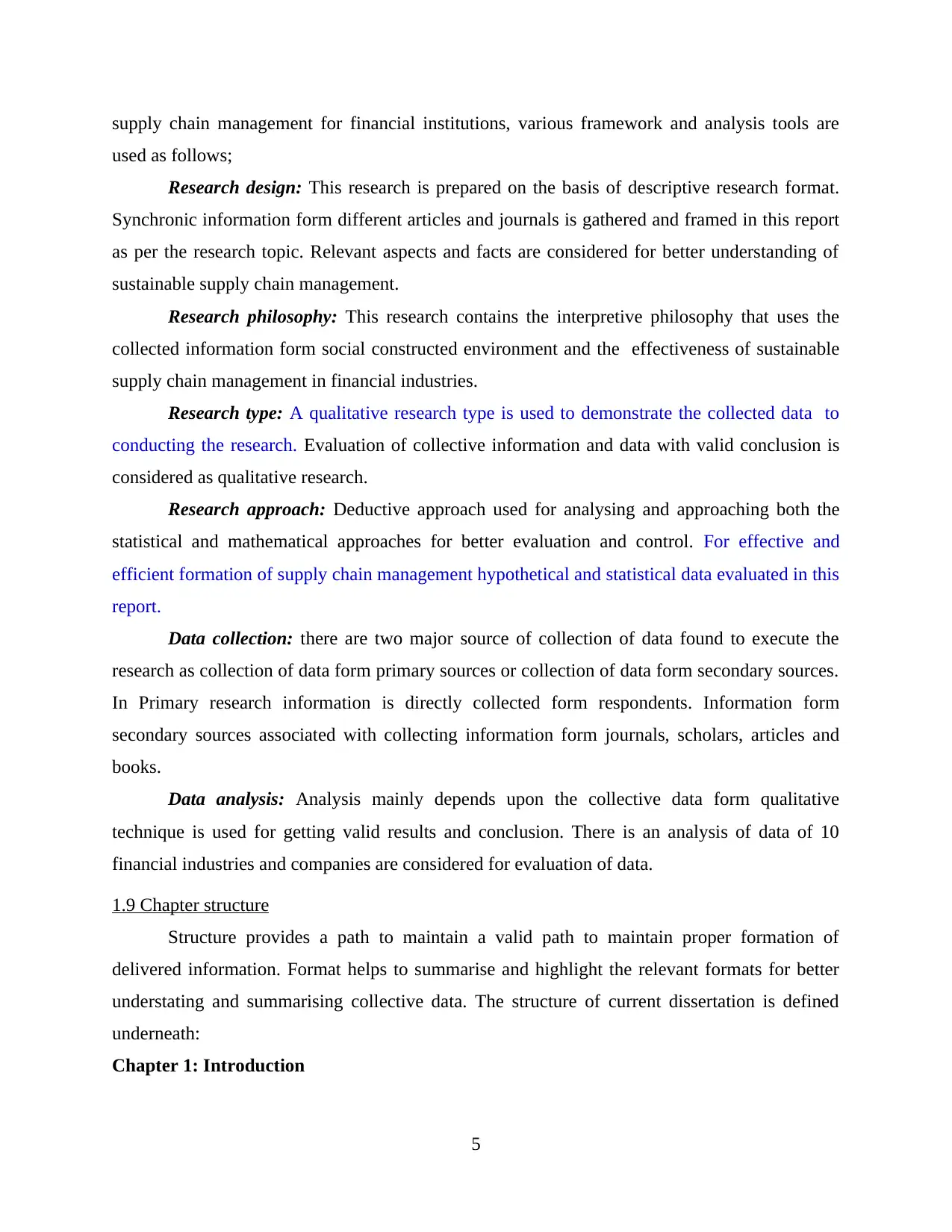
supply chain management for financial institutions, various framework and analysis tools are
used as follows;
Research design: This research is prepared on the basis of descriptive research format.
Synchronic information form different articles and journals is gathered and framed in this report
as per the research topic. Relevant aspects and facts are considered for better understanding of
sustainable supply chain management.
Research philosophy: This research contains the interpretive philosophy that uses the
collected information form social constructed environment and the effectiveness of sustainable
supply chain management in financial industries.
Research type: A qualitative research type is used to demonstrate the collected data to
conducting the research. Evaluation of collective information and data with valid conclusion is
considered as qualitative research.
Research approach: Deductive approach used for analysing and approaching both the
statistical and mathematical approaches for better evaluation and control. For effective and
efficient formation of supply chain management hypothetical and statistical data evaluated in this
report.
Data collection: there are two major source of collection of data found to execute the
research as collection of data form primary sources or collection of data form secondary sources.
In Primary research information is directly collected form respondents. Information form
secondary sources associated with collecting information form journals, scholars, articles and
books.
Data analysis: Analysis mainly depends upon the collective data form qualitative
technique is used for getting valid results and conclusion. There is an analysis of data of 10
financial industries and companies are considered for evaluation of data.
1.9 Chapter structure
Structure provides a path to maintain a valid path to maintain proper formation of
delivered information. Format helps to summarise and highlight the relevant formats for better
understating and summarising collective data. The structure of current dissertation is defined
underneath:
Chapter 1: Introduction
5
used as follows;
Research design: This research is prepared on the basis of descriptive research format.
Synchronic information form different articles and journals is gathered and framed in this report
as per the research topic. Relevant aspects and facts are considered for better understanding of
sustainable supply chain management.
Research philosophy: This research contains the interpretive philosophy that uses the
collected information form social constructed environment and the effectiveness of sustainable
supply chain management in financial industries.
Research type: A qualitative research type is used to demonstrate the collected data to
conducting the research. Evaluation of collective information and data with valid conclusion is
considered as qualitative research.
Research approach: Deductive approach used for analysing and approaching both the
statistical and mathematical approaches for better evaluation and control. For effective and
efficient formation of supply chain management hypothetical and statistical data evaluated in this
report.
Data collection: there are two major source of collection of data found to execute the
research as collection of data form primary sources or collection of data form secondary sources.
In Primary research information is directly collected form respondents. Information form
secondary sources associated with collecting information form journals, scholars, articles and
books.
Data analysis: Analysis mainly depends upon the collective data form qualitative
technique is used for getting valid results and conclusion. There is an analysis of data of 10
financial industries and companies are considered for evaluation of data.
1.9 Chapter structure
Structure provides a path to maintain a valid path to maintain proper formation of
delivered information. Format helps to summarise and highlight the relevant formats for better
understating and summarising collective data. The structure of current dissertation is defined
underneath:
Chapter 1: Introduction
5
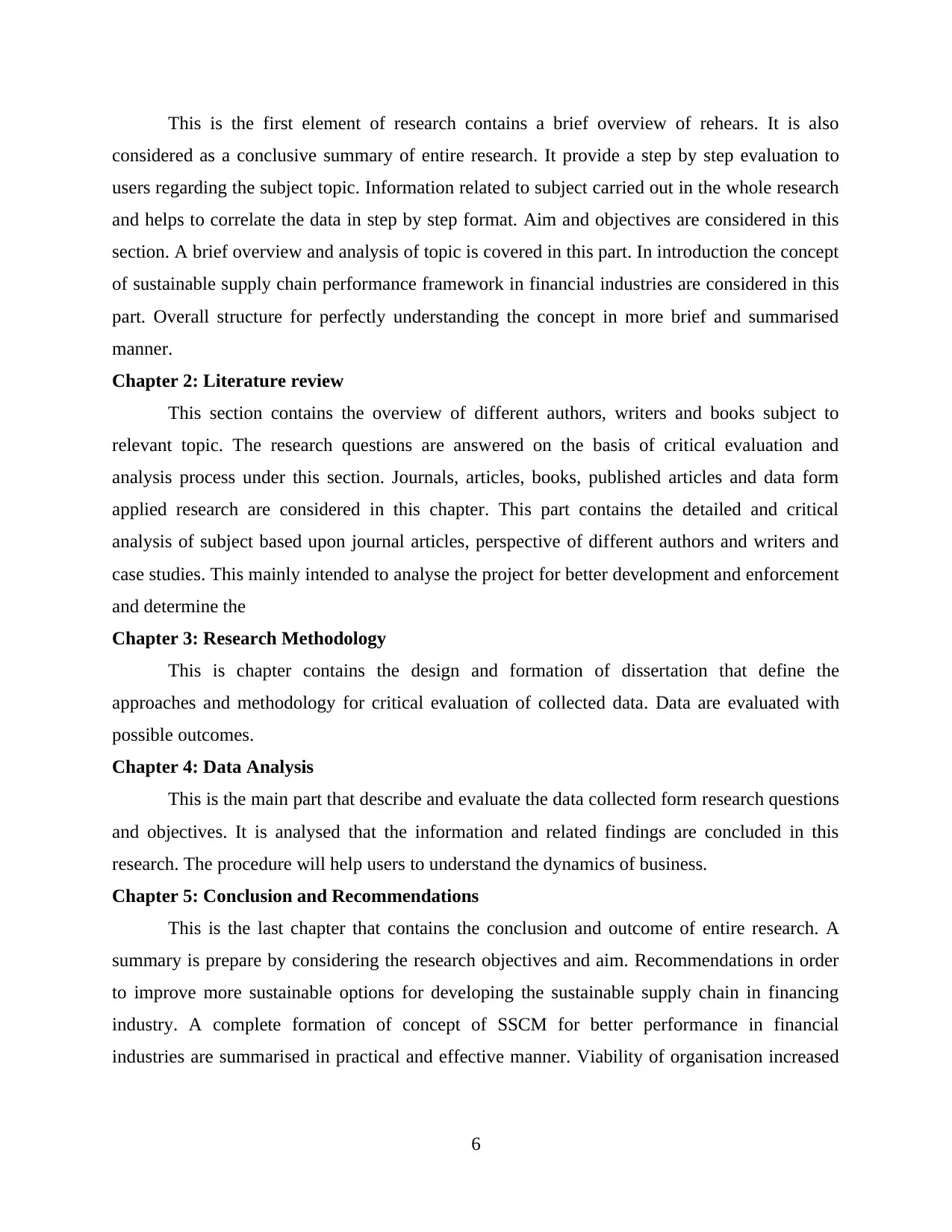
This is the first element of research contains a brief overview of rehears. It is also
considered as a conclusive summary of entire research. It provide a step by step evaluation to
users regarding the subject topic. Information related to subject carried out in the whole research
and helps to correlate the data in step by step format. Aim and objectives are considered in this
section. A brief overview and analysis of topic is covered in this part. In introduction the concept
of sustainable supply chain performance framework in financial industries are considered in this
part. Overall structure for perfectly understanding the concept in more brief and summarised
manner.
Chapter 2: Literature review
This section contains the overview of different authors, writers and books subject to
relevant topic. The research questions are answered on the basis of critical evaluation and
analysis process under this section. Journals, articles, books, published articles and data form
applied research are considered in this chapter. This part contains the detailed and critical
analysis of subject based upon journal articles, perspective of different authors and writers and
case studies. This mainly intended to analyse the project for better development and enforcement
and determine the
Chapter 3: Research Methodology
This is chapter contains the design and formation of dissertation that define the
approaches and methodology for critical evaluation of collected data. Data are evaluated with
possible outcomes.
Chapter 4: Data Analysis
This is the main part that describe and evaluate the data collected form research questions
and objectives. It is analysed that the information and related findings are concluded in this
research. The procedure will help users to understand the dynamics of business.
Chapter 5: Conclusion and Recommendations
This is the last chapter that contains the conclusion and outcome of entire research. A
summary is prepare by considering the research objectives and aim. Recommendations in order
to improve more sustainable options for developing the sustainable supply chain in financing
industry. A complete formation of concept of SSCM for better performance in financial
industries are summarised in practical and effective manner. Viability of organisation increased
6
considered as a conclusive summary of entire research. It provide a step by step evaluation to
users regarding the subject topic. Information related to subject carried out in the whole research
and helps to correlate the data in step by step format. Aim and objectives are considered in this
section. A brief overview and analysis of topic is covered in this part. In introduction the concept
of sustainable supply chain performance framework in financial industries are considered in this
part. Overall structure for perfectly understanding the concept in more brief and summarised
manner.
Chapter 2: Literature review
This section contains the overview of different authors, writers and books subject to
relevant topic. The research questions are answered on the basis of critical evaluation and
analysis process under this section. Journals, articles, books, published articles and data form
applied research are considered in this chapter. This part contains the detailed and critical
analysis of subject based upon journal articles, perspective of different authors and writers and
case studies. This mainly intended to analyse the project for better development and enforcement
and determine the
Chapter 3: Research Methodology
This is chapter contains the design and formation of dissertation that define the
approaches and methodology for critical evaluation of collected data. Data are evaluated with
possible outcomes.
Chapter 4: Data Analysis
This is the main part that describe and evaluate the data collected form research questions
and objectives. It is analysed that the information and related findings are concluded in this
research. The procedure will help users to understand the dynamics of business.
Chapter 5: Conclusion and Recommendations
This is the last chapter that contains the conclusion and outcome of entire research. A
summary is prepare by considering the research objectives and aim. Recommendations in order
to improve more sustainable options for developing the sustainable supply chain in financing
industry. A complete formation of concept of SSCM for better performance in financial
industries are summarised in practical and effective manner. Viability of organisation increased
6
⊘ This is a preview!⊘
Do you want full access?
Subscribe today to unlock all pages.

Trusted by 1+ million students worldwide

by creating the values among stakeholders and customer. Gaining customer interest and
satisfaction is the principle aspect considered in financial supply chain management.
7
satisfaction is the principle aspect considered in financial supply chain management.
7
Paraphrase This Document
Need a fresh take? Get an instant paraphrase of this document with our AI Paraphraser
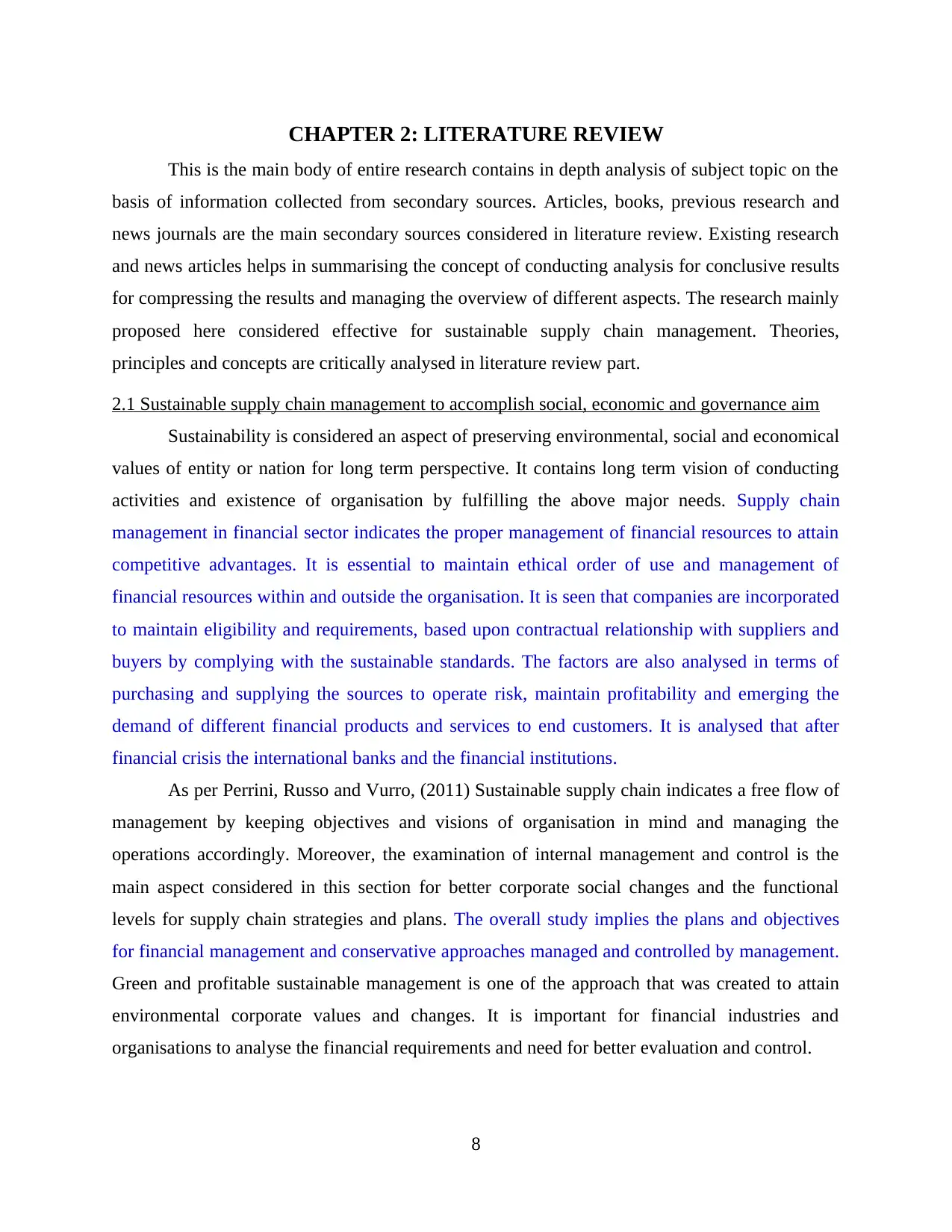
CHAPTER 2: LITERATURE REVIEW
This is the main body of entire research contains in depth analysis of subject topic on the
basis of information collected from secondary sources. Articles, books, previous research and
news journals are the main secondary sources considered in literature review. Existing research
and news articles helps in summarising the concept of conducting analysis for conclusive results
for compressing the results and managing the overview of different aspects. The research mainly
proposed here considered effective for sustainable supply chain management. Theories,
principles and concepts are critically analysed in literature review part.
2.1 Sustainable supply chain management to accomplish social, economic and governance aim
Sustainability is considered an aspect of preserving environmental, social and economical
values of entity or nation for long term perspective. It contains long term vision of conducting
activities and existence of organisation by fulfilling the above major needs. Supply chain
management in financial sector indicates the proper management of financial resources to attain
competitive advantages. It is essential to maintain ethical order of use and management of
financial resources within and outside the organisation. It is seen that companies are incorporated
to maintain eligibility and requirements, based upon contractual relationship with suppliers and
buyers by complying with the sustainable standards. The factors are also analysed in terms of
purchasing and supplying the sources to operate risk, maintain profitability and emerging the
demand of different financial products and services to end customers. It is analysed that after
financial crisis the international banks and the financial institutions.
As per Perrini, Russo and Vurro, (2011) Sustainable supply chain indicates a free flow of
management by keeping objectives and visions of organisation in mind and managing the
operations accordingly. Moreover, the examination of internal management and control is the
main aspect considered in this section for better corporate social changes and the functional
levels for supply chain strategies and plans. The overall study implies the plans and objectives
for financial management and conservative approaches managed and controlled by management.
Green and profitable sustainable management is one of the approach that was created to attain
environmental corporate values and changes. It is important for financial industries and
organisations to analyse the financial requirements and need for better evaluation and control.
8
This is the main body of entire research contains in depth analysis of subject topic on the
basis of information collected from secondary sources. Articles, books, previous research and
news journals are the main secondary sources considered in literature review. Existing research
and news articles helps in summarising the concept of conducting analysis for conclusive results
for compressing the results and managing the overview of different aspects. The research mainly
proposed here considered effective for sustainable supply chain management. Theories,
principles and concepts are critically analysed in literature review part.
2.1 Sustainable supply chain management to accomplish social, economic and governance aim
Sustainability is considered an aspect of preserving environmental, social and economical
values of entity or nation for long term perspective. It contains long term vision of conducting
activities and existence of organisation by fulfilling the above major needs. Supply chain
management in financial sector indicates the proper management of financial resources to attain
competitive advantages. It is essential to maintain ethical order of use and management of
financial resources within and outside the organisation. It is seen that companies are incorporated
to maintain eligibility and requirements, based upon contractual relationship with suppliers and
buyers by complying with the sustainable standards. The factors are also analysed in terms of
purchasing and supplying the sources to operate risk, maintain profitability and emerging the
demand of different financial products and services to end customers. It is analysed that after
financial crisis the international banks and the financial institutions.
As per Perrini, Russo and Vurro, (2011) Sustainable supply chain indicates a free flow of
management by keeping objectives and visions of organisation in mind and managing the
operations accordingly. Moreover, the examination of internal management and control is the
main aspect considered in this section for better corporate social changes and the functional
levels for supply chain strategies and plans. The overall study implies the plans and objectives
for financial management and conservative approaches managed and controlled by management.
Green and profitable sustainable management is one of the approach that was created to attain
environmental corporate values and changes. It is important for financial industries and
organisations to analyse the financial requirements and need for better evaluation and control.
8
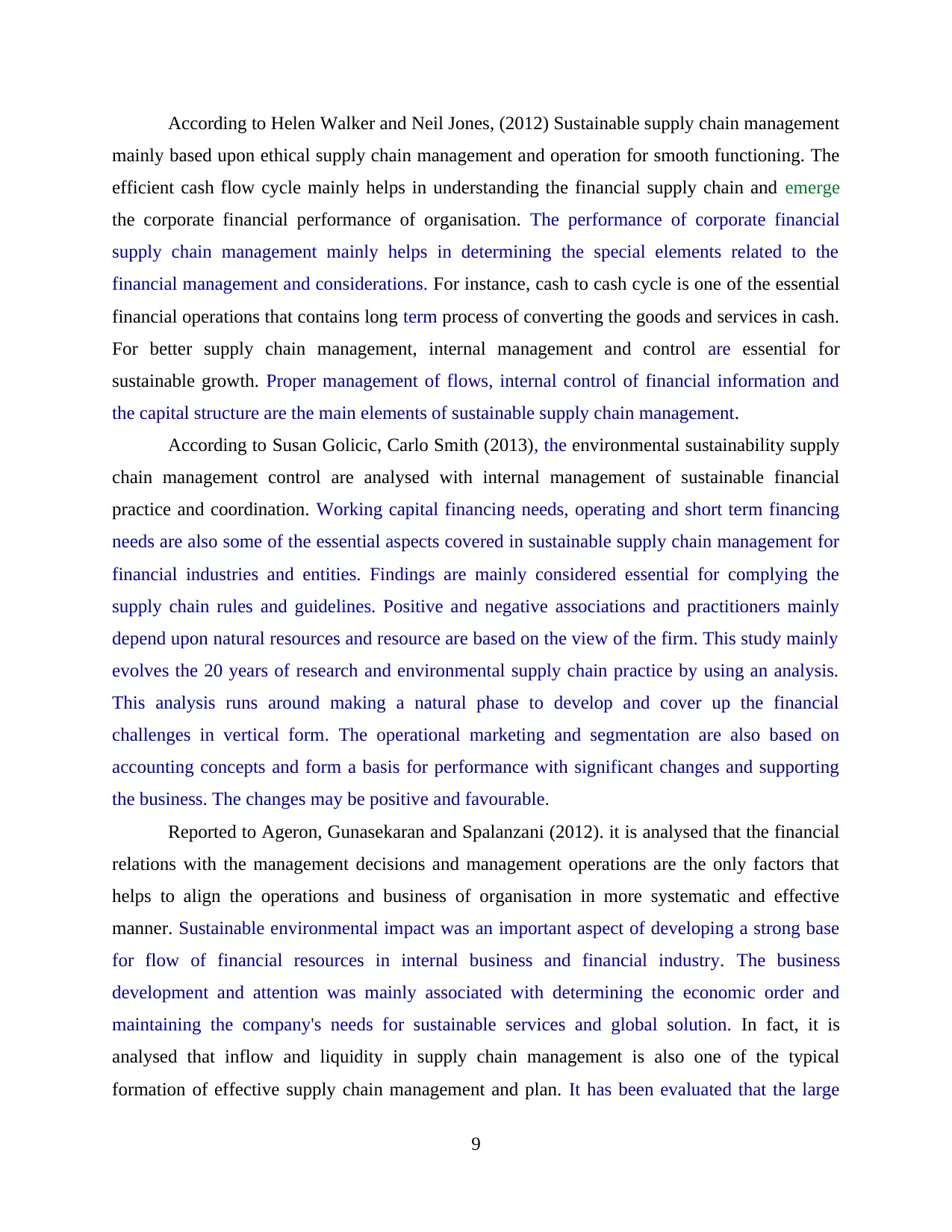
According to Helen Walker and Neil Jones, (2012) Sustainable supply chain management
mainly based upon ethical supply chain management and operation for smooth functioning. The
efficient cash flow cycle mainly helps in understanding the financial supply chain and emerge
the corporate financial performance of organisation. The performance of corporate financial
supply chain management mainly helps in determining the special elements related to the
financial management and considerations. For instance, cash to cash cycle is one of the essential
financial operations that contains long term process of converting the goods and services in cash.
For better supply chain management, internal management and control are essential for
sustainable growth. Proper management of flows, internal control of financial information and
the capital structure are the main elements of sustainable supply chain management.
According to Susan Golicic, Carlo Smith (2013), the environmental sustainability supply
chain management control are analysed with internal management of sustainable financial
practice and coordination. Working capital financing needs, operating and short term financing
needs are also some of the essential aspects covered in sustainable supply chain management for
financial industries and entities. Findings are mainly considered essential for complying the
supply chain rules and guidelines. Positive and negative associations and practitioners mainly
depend upon natural resources and resource are based on the view of the firm. This study mainly
evolves the 20 years of research and environmental supply chain practice by using an analysis.
This analysis runs around making a natural phase to develop and cover up the financial
challenges in vertical form. The operational marketing and segmentation are also based on
accounting concepts and form a basis for performance with significant changes and supporting
the business. The changes may be positive and favourable.
Reported to Ageron, Gunasekaran and Spalanzani (2012). it is analysed that the financial
relations with the management decisions and management operations are the only factors that
helps to align the operations and business of organisation in more systematic and effective
manner. Sustainable environmental impact was an important aspect of developing a strong base
for flow of financial resources in internal business and financial industry. The business
development and attention was mainly associated with determining the economic order and
maintaining the company's needs for sustainable services and global solution. In fact, it is
analysed that inflow and liquidity in supply chain management is also one of the typical
formation of effective supply chain management and plan. It has been evaluated that the large
9
mainly based upon ethical supply chain management and operation for smooth functioning. The
efficient cash flow cycle mainly helps in understanding the financial supply chain and emerge
the corporate financial performance of organisation. The performance of corporate financial
supply chain management mainly helps in determining the special elements related to the
financial management and considerations. For instance, cash to cash cycle is one of the essential
financial operations that contains long term process of converting the goods and services in cash.
For better supply chain management, internal management and control are essential for
sustainable growth. Proper management of flows, internal control of financial information and
the capital structure are the main elements of sustainable supply chain management.
According to Susan Golicic, Carlo Smith (2013), the environmental sustainability supply
chain management control are analysed with internal management of sustainable financial
practice and coordination. Working capital financing needs, operating and short term financing
needs are also some of the essential aspects covered in sustainable supply chain management for
financial industries and entities. Findings are mainly considered essential for complying the
supply chain rules and guidelines. Positive and negative associations and practitioners mainly
depend upon natural resources and resource are based on the view of the firm. This study mainly
evolves the 20 years of research and environmental supply chain practice by using an analysis.
This analysis runs around making a natural phase to develop and cover up the financial
challenges in vertical form. The operational marketing and segmentation are also based on
accounting concepts and form a basis for performance with significant changes and supporting
the business. The changes may be positive and favourable.
Reported to Ageron, Gunasekaran and Spalanzani (2012). it is analysed that the financial
relations with the management decisions and management operations are the only factors that
helps to align the operations and business of organisation in more systematic and effective
manner. Sustainable environmental impact was an important aspect of developing a strong base
for flow of financial resources in internal business and financial industry. The business
development and attention was mainly associated with determining the economic order and
maintaining the company's needs for sustainable services and global solution. In fact, it is
analysed that inflow and liquidity in supply chain management is also one of the typical
formation of effective supply chain management and plan. It has been evaluated that the large
9
⊘ This is a preview!⊘
Do you want full access?
Subscribe today to unlock all pages.

Trusted by 1+ million students worldwide
1 out of 39
Related Documents
Your All-in-One AI-Powered Toolkit for Academic Success.
+13062052269
info@desklib.com
Available 24*7 on WhatsApp / Email
![[object Object]](/_next/static/media/star-bottom.7253800d.svg)
Unlock your academic potential
Copyright © 2020–2025 A2Z Services. All Rights Reserved. Developed and managed by ZUCOL.




